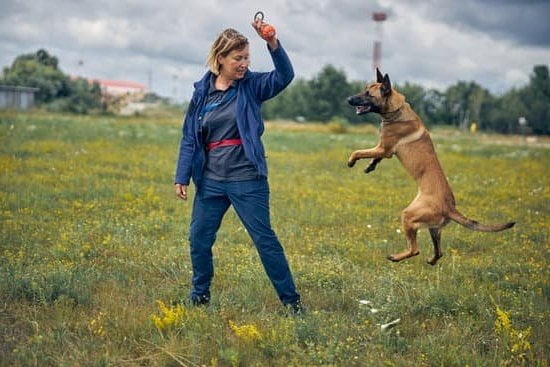Police dogs, also known as K9 units, play a crucial role in law enforcement, often aiding officers in a variety of duties such as search and rescue operations, tracking down suspects, and detecting illegal substances. One of the most fascinating aspects of police dog work is their remarkable sense of smell and the extensive training they undergo to utilize it effectively.
In this article, we will explore the intriguing world of police dog training and focus on what these highly skilled animals are specifically trained to sniff out.
The history of police dog training dates back centuries, with the use of canines for law enforcement purposes traced back to ancient civilizations. Over time, the training methods have evolved significantly, resulting in the development of specialized breeds preferred for police work. From German Shepherds to Belgian Malinois, specific breeds are selected based on their intelligence, physical capabilities, and keen sense of smell.
Unveiling the rigorous training process that police dogs undergo is essential to understanding their significant contributions in law enforcement. This involves intense preparation to identify targeted scents accurately against various distractions and challenges they may face in real-life scenarios. Moreover, it’s vital to delve into what exactly these remarkable animals are trained to detect and why their role is indispensable in keeping our communities safe.
The History of Police Dog Training
Police dogs have a storied history dating back to ancient times, where they were often used for their incredible sense of smell and tracking abilities in various forms of law enforcement. One of the earliest recorded uses of dogs in police work was in ancient Greece, where they were used to track and apprehend criminals.
The idea of using dogs as part of law enforcement continued through the years, with different breeds being used for specific tasks such as tracking, search and rescue, and locating contraband.
Evolution of Training Techniques
The training techniques for police dogs have evolved significantly over the years. In the past, training methods were often harsh and punishment-based. However, modern training techniques focus on positive reinforcement and building a strong bond between the canine officer and their handler. This shift in training practices has led to more successful outcomes in police work and has helped solidify the role of police dogs as valuable members of law enforcement teams.
Standardization of Training
In recent decades, efforts have been made to standardize police dog training programs and certification processes. This ensures that all police dogs receive consistent and rigorous training regardless of their specific task or location. These standardized programs also help ensure that these highly trained animals are capable of performing their duties effectively while protecting both themselves and their handlers in high-pressure situations.
The Breeds of Dogs Used in Police Work
German Shepherd
The German Shepherd is one of the most commonly used breeds in police work due to its intelligence, agility, and strong sense of smell. This breed is often trained for various tasks such as tracking, searching for drugs and explosives, and apprehending suspects.
Belgian Malinois
Another popular breed used in police work is the Belgian Malinois. Similar to the German Shepherd, this breed is known for its high energy level, intelligence, and keen sense of smell. Belgian Malinois are often used in military and police work for tasks such as detection work and search and rescue missions.
Laboratory Retriever
Labrador Retrievers are also frequently used in police work due to their friendly nature and exceptional olfactory abilities. They are often trained for sniffing out narcotics, explosives, or even missing persons.
These breeds are preferred for police work due to their trainability, physical capabilities, as well as their natural instincts that make them well-suited for scent detection duties. Selecting the right breed plays a crucial role in the successful training and performance of police dogs in law enforcement.
The Rigorous Training Process for Police Dogs
Police dogs undergo a rigorous training process to develop their skills in scent detection, obedience, and agility. The first step in this process is selecting the right candidate for police work. Generally, breeds such as German Shepherds, Belgian Malinois, and Labrador Retrievers are favored due to their intelligence, strength, and keen sense of smell. Once a suitable candidate is chosen, they begin their training which can take several months to complete.
During the training process, police dogs are taught to detect a wide range of drugs including marijuana, cocaine, heroin, and methamphetamines. They are also trained to detect explosives such as TNT, C-4, and other dangerous substances that pose a threat to public safety. This requires intense and repetitive exercises where the dogs learn to identify the specific scents associated with these substances.
Moreover, part of the rigorous training includes teaching the dogs how to remain focused in various environments such as crowded public spaces or in high-stress situations. Additionally, they are trained to follow commands from their handlers without hesitation which is crucial in ensuring their effectiveness in actual police operations.
| Police Dog Training Skills | Description |
|---|---|
| Scent Detection | Dogs are trained for months on detecting drugs and explosives. |
| Obedience | They learn to obey commands from their handlers without hesitation. |
| Agility | Dogs develop physical agility necessary for maneuvering through obstacles. |
What Are Police Dogs Trained to Smell
While not all police dogs are trained to detect drugs, the majority of them are primarily trained to smell drugs and explosives. The rigorous training process that police dogs undergo allows them to use their superior sense of smell to detect even trace amounts of these substances with remarkable accuracy. Some of the specific scents that police dogs are trained to detect include:
- Marijuana
- Cocaine
- Heroin
- Methamphetamine
- Explosives such as TNT and C4
Police dogs go through extensive training to recognize and respond to these specific scents, which is crucial in law enforcement activities such as drug busts, bomb detection, and search and rescue operations.
The ability of police dogs to detect these substances plays a vital role in law enforcement efforts, as they can quickly identify the presence of drugs or explosives in various environments. This skill not only helps in preventing illegal activities or potential threats but also assists in solving criminal cases by providing critical evidence for prosecution.
The Importance of Scent Detection in Police Work
Police dogs are trained to detect a variety of scents in their line of work, with drugs and explosives being the most common targets. These highly-skilled animals are able to detect even trace amounts of these substances with remarkable accuracy due to their superior sense of smell. In addition to drugs and explosives, police dogs can also be trained to detect other scents such as firearms, currency, and even human remains.
The ability of police dogs to detect these various scents is crucial in law enforcement operations. By using their keen sense of smell, they can help law enforcement officers locate illegal substances, dangerous weapons, and evidence at crime scenes which may not be visible to the naked eye. Furthermore, the use of police dogs in scent detection has been instrumental in preventing criminal activity by intercepting narcotics shipments and uncovering hidden explosive devices.
In essence, the training of police dogs in scent detection plays a significant role in the overall effectiveness and success of law enforcement operations. Their unique olfactory abilities make them valuable assets to law enforcement agencies worldwide and contribute greatly to keeping communities safe from harm.
| Substance | Commonly Used Breeds |
|---|---|
| Drugs | German Shepherd, Belgian Malinois |
| Explosives | Labrador Retriever, Springer Spaniel |
| Firearms | Vizsla, Weimaraner |
Real Life Examples of Police Dogs Using Their Sense of Smell to Solve Cases
Police dogs have been instrumental in solving countless cases through their exceptional sense of smell. Here are some real-life examples of police dogs using their sense of smell to solve cases:
1. Drug Busts: Police dogs have played a vital role in uncovering hidden stashes of drugs during routine traffic stops, airport inspections, and raids. Their ability to sniff out even the smallest amount of narcotics has led to numerous arrests and the seizure of illegal substances.
2. Explosive Detection: In high-security areas such as airports and government buildings, police dogs trained to detect explosives have prevented potential disasters by alerting their handlers to the presence of dangerous materials. Their keen sense of smell has been crucial in preventing acts of terrorism and keeping the public safe.
3. Search and Rescue Operations: Police dogs trained for search and rescue missions have located missing persons, whether they were lost in the wilderness or trapped under debris after natural disasters. These dogs can pick up on human scent even when it is faint or obscured, leading rescuers to individuals in need of assistance.
These examples illustrate the invaluable contribution that police dogs make to law enforcement and public safety through their remarkable olfactory capabilities. Whether it’s detecting drugs, explosives, or locating missing individuals, these highly trained animals continue to play a crucial role in solving cases and keeping communities safe.
The Ongoing Work of Police Dogs in Keeping Communities Safe
In conclusion, police dogs play a crucial role in law enforcement and continue to be valuable assets in keeping communities safe. The history of police dog training has shown the evolution of their roles, from being used for tracking and patrolling to now being trained for scent detection. The breeds of dogs used in police work are carefully selected based on their physical and behavioral traits, with breeds like German Shepherds, Belgian Malinois, and Labrador Retrievers being popular choices.
The rigorous training process for police dogs involves obedience training, agility exercises, and most importantly, scent detection training. While not all police dogs are trained to detect drugs and explosives, these substances are predominantly what they are trained to smell due to their ability to detect even trace amounts with great accuracy. This makes them valuable in detecting illegal substances and preventing potential threats to public safety.
Real life examples have demonstrated the importance of scent detection in police work, with numerous cases where police dogs have successfully located hidden drugs or explosives that may have otherwise gone undetected. Their ability to locate these substances has led to the apprehension of criminals and the prevention of illegal activities. As such, the ongoing work of police dogs is vital in maintaining public safety and upholding the law.
Frequently Asked Questions
Are Police Dogs Trained to Smell Everything?
Police dogs are not trained to smell everything, but they are trained to detect specific odors related to their duties. These can include drugs, explosives, electronics, or even human scent for search and rescue missions.
What Drugs Are Drug Dogs Trained to Smell?
Drug dogs are specifically trained to detect a range of illegal substances including marijuana, heroin, cocaine, ecstasy, methamphetamine, and other narcotics. They undergo rigorous training to be able to identify these scents in various environments such as airports, vehicles, or buildings.
Are Police Dogs Trained to Smell Nicotine?
Some police dogs may also be trained to smell nicotine, but this is less common than training them for drugs or explosives. The use of nicotine-detecting dogs may vary depending on the specific needs and policies of law enforcement agencies.

Welcome to the blog! I am a professional dog trainer and have been working with dogs for many years. In this blog, I will be discussing various topics related to dog training, including tips, tricks, and advice. I hope you find this information helpful and informative. Thanks for reading!





